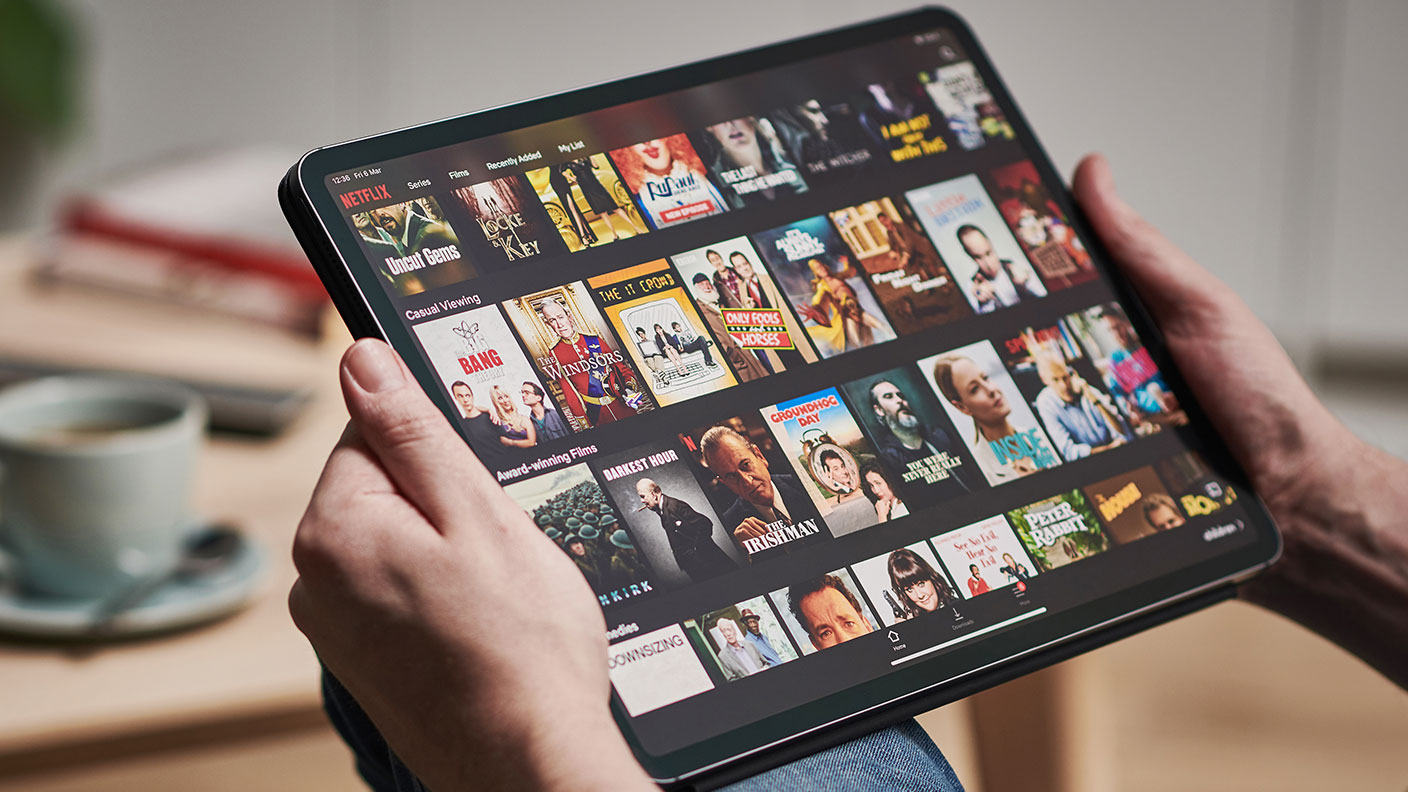
“The trend is your friend,” according to the old investment adage. Nowhere is this more true than in the media and entertainment sector. The rise of streaming services such as Netflix and Amazon Prime Video, online video-sharing sites such as YouTube, and social-media platforms such as Facebook, Instagram and TikTok, has broken the vice-like grip that television broadcasters and cinemas used to have on our viewing habits.
At the heart of each of these internet-enabled services lies a simple but compelling “on-demand” offer – they allow us to watch what we want when we want. These global platforms grew more popular than ever during the pandemic, which accelerated the shift of viewing away from broadcast television and cinema.
Consider regulator Ofcom’s Media Nations research into the country’s viewing habits. Even though people watched more broadcast television during the pandemic, TV’s actual share of total viewing fell from 67% in 2019 to 61% in 2020. Ofcom also found that young people aged 16-34 are abandoning live TV. They spend more time each day on streaming services (91 minutes) and YouTube (72 minutes) than on watching live TV (65 minutes).
MoneyWeek
Subscribe to MoneyWeek today and get your first six magazine issues absolutely FREE

Sign up to Money Morning
Don't miss the latest investment and personal finances news, market analysis, plus money-saving tips with our free twice-daily newsletter
Don't miss the latest investment and personal finances news, market analysis, plus money-saving tips with our free twice-daily newsletter
Teenagers abandon the telly
The figures back up a trend many of us observe in our home lives. Any family with teenagers will know that they hardly ever tune into live TV, preferring a diet of Netflix, YouTube and TikTok. Those who have put their money on this trend have done well. Netflix’s share price has gained around a fifth in the past year and 390% in five years. YouTube-parent Alphabet is up by 70% and 262% respectively.
Investors who have backed traditional media firms, however, have fared less impressively. Despite diversifying into production and launching its own streaming services – ITV Hub and BritBox – ITV’s share price has declined marginally in the past year, and by 45% in five years. Cinema operator Cineworld has slumped by a respective 50% and 87% over the same period. The big question now is whether you should follow the trend and back global video platforms, or bet that traditional players can bounce back and adapt to the age of online streaming.
The choice is not as straightforward as it might seem. Streamers such as Netflix are highly valued, with a price-to-earnings ratio of 54. There are signs that its growth may have plateaued after it aggressively added subscribers during the pandemic. In its core US and Canada market, Netflix only added 70,000 net paid subscribers in the first three months of 2021.
A frenzy of activity
The streaming market is also highly competitive. Technology and media analyst Omdia reckons there are now more than 5,300 streaming services around the world. The likes of Netflix, Disney+, Amazon Prime Video, HBO Max, Apple TV+, Paramount+ and Discovery+ are spending fortunes on content to make sure they are one of the handful of services that households are prepared to pay for. Netflix is investing $13.6bn on programming this year, funding expensive dramas such as The Crown and The Witcher, as well as action film Red Notice, starring Dwayne Johnson and Ryan Reynolds.
Not to be outdone, Disney plans to turbocharge its content spending next year. It has raised its content budget by $8bn to $33bn. A large proportion of this will be earmarked for films and series for its Disney+ platform. Discovery and WarnerMedia, which run the Discovery+ and HBO Max platforms respectively and are in the process of merging, plan jointly to spend $20bn on content.
In the face of competition from global streamers, British firms are adapting. The BBC, ITV, and Channel 4 each have compelling platforms of their own: BBC iPlayer, ITV Hub and All4. The BBC and ITV have also teamed up to launch BritBox, which offers UK programming highlights and is being launched around the world.
ITV recently said it expects to generate £1.95bn in advertising revenue in 2021 – a company record – on the back of a buoyant economy. Its production arm, ITV Studios, has also seen revenues rise as it capitalises on the demand for original content. It makes shows for an array of broadcasters and streamers, including BBC1’s Vigil, ITV’s The Long Call, Netflix’s Snowpiercer Season 2, Apple TV+’s Physical and HBO Max’s Ten Year Old Tom.
Cinemas too are attracting back growing audiences after the disastrous lockdown closures of 2020. Gower Street Analytics has predicted overall global box-office takings of $21bn for 2021, with top films including The Battle at Lake Changjin, No Time To Die and F9: The Fast Saga. The figure is still half of 2019’s total. But it is a 75% increase from 2020. Gower Street forecasts that box-office revenues will rise by another 58% to $33.2bn in 2022. Despite all this, analysts firmly believe that the leading global-streaming platforms will continue to dominate the media and entertainment market. “The future is streaming,” says Tom Harrington, head of television at Enders Analysis, a media and entertainment market researcher. “Video will all be online.”
Netflix cements its dominance
Maria Rua Aguete, Omdia’s senior research director for TV, video and advertising, forecasts that Netflix will still be the number-one streaming platform in 2025, with 255 million subscribers, up from 2020’s 204 million. Disney+ will be in second place with 248 million, and Amazon Prime Video third with 161 million.
She notes that Netflix is also expanding beyond video into video games and sales of merchandise related to its shows. Rua Aguete says that Netflix’s content spend isn’t the only reason for its success; the streamer is also highly skilled at partnering with telecoms groups and operators around the world to make the platform very easy to access for subscribers.
Netflix’s technology – from its recommendation algorithms to its user interface – is also considered better than rival versions. Furthermore, Netflix has recently shown signs that it is prepared to be flexible on price in order to gain subscribers.
Last month it announced that it was cutting its subscription costs by up to 60% in the price-sensitive and strategically important Indian market, where Disney and Amazon are currently ahead. Meanwhile, Enders Analysis predicts that the content arms race between the streaming platforms will soon show signs of easing as they shift from focusing on gaining market share to focusing on profitability.
“We think the perceived value of content is declining,” Harrington says. He explains that audiences are spending less on content than they have in the past and currently have much more choice. Audiences are also watching less long-form content owing to competition from short-form platforms such as YouTube, TikTok and Instagram. Streamers are therefore likely to cut the amount they spend on content in future years. Certainly, much of the streamers’ content spending seems wildly inefficient: many expensive shows are barely watched after their first thirty days on a platform. The logical conclusion of this argument is that if streamers spend less, the streamer-driven growth model of many content producers will also come under threat.
The top stocks in the sector
Market leadership, a strong content pipeline, cutting-edge technology, effective partnerships and global scale make Netflix (Nasdaq: NFLX) a good long-term bet. Netflix’s programming has been popular worldwide, and its strategy of investing in local content with global appeal – such as Korean hit Squid Game, French thriller Lupin and Spanish drama Money Heist – is paying off.
Walt Disney (NYSE: DIS) has impressed with the launch of Disney+. It has brought a direct-to-consumer streamer to market, pivoting away from profitably distributing its content through third-party channels and platforms. For a legacy media firm, it was a bold and transformative bet that has been well executed. Many within the industry are bullish about Disney’s prospects, pointing to its unrivalled content that appeals to young and older viewers alike. In addition to Walt Disney Pictures, it owns Pixar, 20th Century Fox, Lucasfilm and Marvel Studios.
YouTube parent Alphabet (Nasdaq: GOOGL) has thrived as younger audiences in particular watch more and more content on the video-sharing website. Advertising money has followed the eyeballs, allowing YouTube to raise advertisement prices. Traditionally, YouTube has scooped up advertising from smaller companies, while TV has been viewed as the key bedrock for campaigns by major brands. More recently, big brands are realising that a combination of digital platforms, such as YouTube, and TV is a powerful mix for reaching audiences.
Advertising revenues at ITV (LSE: ITV) are currently very robust and this looks set to continue into the first quarter of the year based on early booking indicators, according to Sarah Simon, an analyst at investment bank Berenberg. However, investors are sceptical about whether this is sustainable. With more competition than ever, total viewing at ITV is declining. Investors perceive that “the money will follow that decline”, says Simon. Berenberg recommends holding ITV.
Cinema chains such Cineworld and Everyman Cinemas have struggled to regain their pre-pandemic highs. Recovery in cinema-going seems to be taking longer than expected, and new Covid-19 variants have not helped; neither has the decision of Hollywood studios to cut the release window of big films to just 45 days before they appear on their streaming platforms. Other shares worthy of research include those of firms that supply the video platforms and content creators. In the UK, these include Zoo Digital (LSE: ZOO), which provides subtitling and dubbing services; Vitec Group (LSE: VTC), a supplier of production kit and software; and video-editing firm Blackbird (LSE: BIRD).
Get the latest financial news, insights and expert analysis from our award-winning MoneyWeek team, to help you understand what really matters when it comes to your finances.
-
 ‘Why I have ditched my Help to Buy ISA for cash savings and the stock market’
‘Why I have ditched my Help to Buy ISA for cash savings and the stock market’Without the 25% bonus, my Help to Buy ISA is effectively redundant, says MoneyWeek writer Sam Walker.
-
 Is your inheritance tax allowance cut if you sell to downsize or sell your home to pay for care?
Is your inheritance tax allowance cut if you sell to downsize or sell your home to pay for care?Downsizing relief is a little-known benefit that could save your loved ones tens of thousands of pounds in inheritance tax after you’ve died.
-
 Stock markets have a mountain to climb: opt for resilience, growth and value
Stock markets have a mountain to climb: opt for resilience, growth and valueOpinion Julian Wheeler, partner and US equity specialist, Shard Capital, highlights three US stocks where he would put his money
-
 The steady rise of stablecoins
The steady rise of stablecoinsInnovations in cryptocurrency have created stablecoins, a new form of money. Trump is an enthusiastic supporter, but its benefits are not yet clear
-
 SRT Marine Systems: A leader in marine technology
SRT Marine Systems: A leader in marine technologySRT Marine Systems is thriving and has a bulging order book, says Dr Michael Tubbs
-
 Goodwin: A superlative British manufacturer to buy now
Goodwin: A superlative British manufacturer to buy nowVeteran engineering group Goodwin has created a new profit engine. But following its tremendous run, can investors still afford the shares?
-
 A change in leadership: Is US stock market exceptionalism over?
A change in leadership: Is US stock market exceptionalism over?US stocks trailed the rest of the world in 2025. Is this a sign that a long-overdue shift is underway?
-
 A reckoning is coming for unnecessary investment trusts
A reckoning is coming for unnecessary investment trustsInvestment trusts that don’t use their structural advantages will find it increasingly hard to survive, says Rupert Hargreaves
-
 Metals and AI power emerging markets
Metals and AI power emerging marketsThis year’s big emerging market winners have tended to offer exposure to one of 2025’s two winning trends – AI-focused tech and the global metals rally
-
 8 of the best houses for sale with beautiful fireplaces
8 of the best houses for sale with beautiful fireplacesThe best houses for sale with beautiful fireplaces – from a 15th-century cottage in Kent to a 17th-century palazzo in Oxfordshire